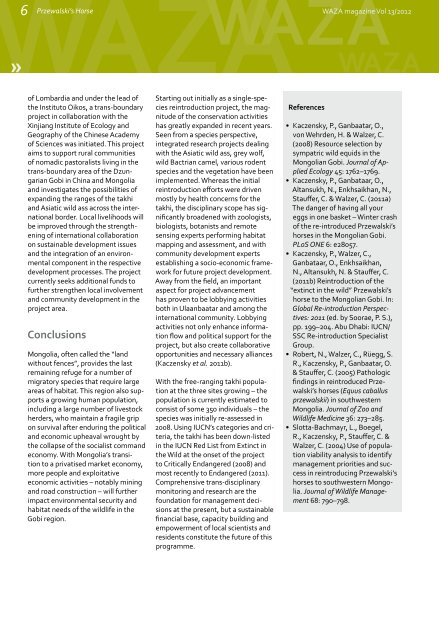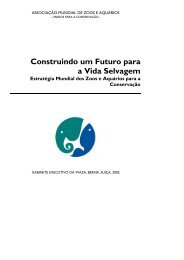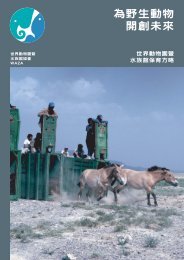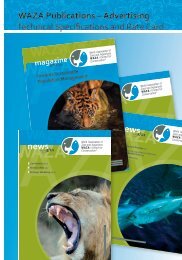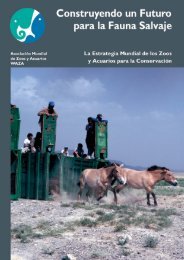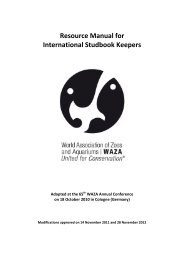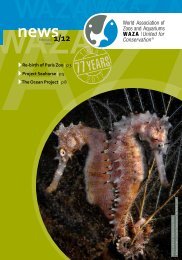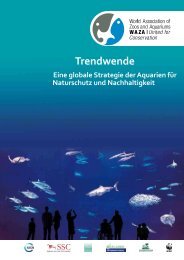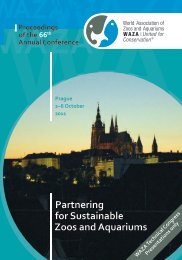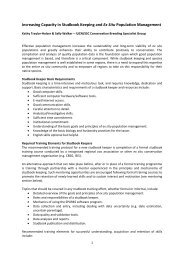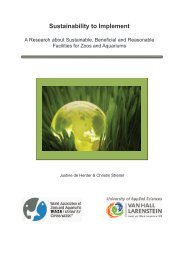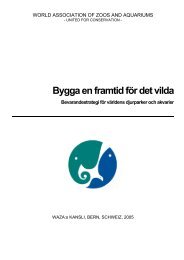Fighting Extinction - Waza
Fighting Extinction - Waza
Fighting Extinction - Waza
Create successful ePaper yourself
Turn your PDF publications into a flip-book with our unique Google optimized e-Paper software.
»<br />
6 Przewalski’s Horse<br />
WAZA magazine Vol 13/2012<br />
of Lombardia and under the lead of<br />
the Instituto Oikos, a trans-boundary<br />
project in collaboration with the<br />
Xinjiang Institute of Ecology and<br />
Geography of the Chinese Academy<br />
of Sciences was initiated. This project<br />
aims to support rural communities<br />
of nomadic pastoralists living in the<br />
trans-boundary area of the Dzungarian<br />
Gobi in China and Mongolia<br />
and investigates the possibilities of<br />
expanding the ranges of the takhi<br />
and Asiatic wild ass across the international<br />
border. Local livelihoods will<br />
be improved through the strengthening<br />
of international collaboration<br />
on sustainable development issues<br />
and the integration of an environmental<br />
component in the respective<br />
development processes. The project<br />
currently seeks additional funds to<br />
further strengthen local involvement<br />
and community development in the<br />
project area.<br />
Conclusions<br />
Mongolia, often called the “land<br />
without fences”, provides the last<br />
remaining refuge for a number of<br />
migratory species that require large<br />
areas of habitat. This region also supports<br />
a growing human population,<br />
including a large number of livestock<br />
herders, who maintain a fragile grip<br />
on survival after enduring the political<br />
and economic upheaval wrought by<br />
the collapse of the socialist command<br />
economy. With Mongolia’s transition<br />
to a privatised market economy,<br />
more people and exploitative<br />
economic activities – notably mining<br />
and road construction – will further<br />
impact environmental security and<br />
habitat needs of the wildlife in the<br />
Gobi region.<br />
Starting out initially as a single-species<br />
reintroduction project, the magnitude<br />
of the conservation activities<br />
has greatly expanded in recent years.<br />
Seen from a species perspective,<br />
integrated research projects dealing<br />
with the Asiatic wild ass, grey wolf,<br />
wild Bactrian camel, various rodent<br />
species and the vegetation have been<br />
implemented. Whereas the initial<br />
reintroduction efforts were driven<br />
mostly by health concerns for the<br />
takhi, the disciplinary scope has significantly<br />
broadened with zoologists,<br />
biologists, botanists and remote<br />
sensing experts performing habitat<br />
mapping and assessment, and with<br />
community development experts<br />
establishing a socio-economic framework<br />
for future project development.<br />
Away from the field, an important<br />
aspect for project advancement<br />
has proven to be lobbying activities<br />
both in Ulaanbaatar and among the<br />
international community. Lobbying<br />
activities not only enhance information<br />
flow and political support for the<br />
project, but also create collaborative<br />
opportunities and necessary alliances<br />
(Kaczensky et al. 2011b).<br />
With the free-ranging takhi population<br />
at the three sites growing – the<br />
population is currently estimated to<br />
consist of some 350 individuals – the<br />
species was initially re-assessed in<br />
2008. Using IUCN’s categories and criteria,<br />
the takhi has been down-listed<br />
in the IUCN Red List from Extinct in<br />
the Wild at the onset of the project<br />
to Critically Endangered (2008) and<br />
most recently to Endangered (2011).<br />
Comprehensive trans-disciplinary<br />
monitoring and research are the<br />
foundation for management decisions<br />
at the present, but a sustainable<br />
financial base, capacity building and<br />
empowerment of local scientists and<br />
residents constitute the future of this<br />
programme.<br />
References<br />
• Kaczensky, P., Ganbaatar, O.,<br />
von Wehrden, H. & Walzer, C.<br />
(2008) Resource selection by<br />
sympatric wild equids in the<br />
Mongolian Gobi. Journal of Applied<br />
Ecology 45: 1762–1769.<br />
• Kaczensky, P., Ganbataar, O.,<br />
Altansukh, N., Enkhsaikhan, N.,<br />
Stauffer, C. & Walzer, C. (2011a)<br />
The danger of having all your<br />
eggs in one basket – Winter crash<br />
of the re-introduced Przewalski’s<br />
horses in the Mongolian Gobi.<br />
PLoS ONE 6: e28057.<br />
• Kaczensky, P., Walzer, C.,<br />
Ganbataar, O., Enkhsaikhan,<br />
N., Altansukh, N. & Stauffer, C.<br />
(2011b) Reintroduction of the<br />
“extinct in the wild” Przewalski’s<br />
horse to the Mongolian Gobi. In:<br />
Global Re-introduction Perspectives:<br />
2011 (ed. by Soorae, P. S.),<br />
pp. 199–204. Abu Dhabi: IUCN/<br />
SSC Re-introduction Specialist<br />
Group.<br />
• Robert, N., Walzer, C., Rüegg, S.<br />
R., Kaczensky, P., Ganbaatar, O.<br />
& Stauffer, C. (2005) Pathologic<br />
findings in reintroduced Przewalski’s<br />
horses (Equus caballus<br />
przewalskii) in southwestern<br />
Mongolia. Journal of Zoo and<br />
Wildlife Medicine 36: 273–285.<br />
• Slotta-Bachmayr, L., Boegel,<br />
R., Kaczensky, P., Stauffer, C. &<br />
Walzer, C. (2004) Use of population<br />
viability analysis to identify<br />
management priorities and success<br />
in reintroducing Przewalski’s<br />
horses to southwestern Mongolia.<br />
Journal of Wildlife Management<br />
68: 790–798.


